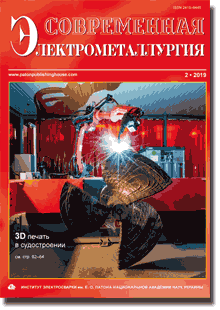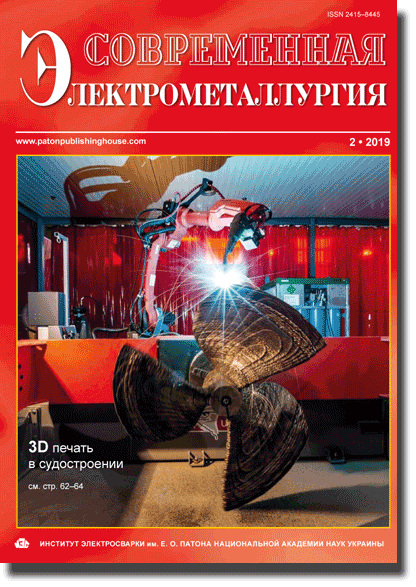| 2019 №02 (02) |
DOI of Article 10.15407/sem2019.02.03 |
2019 №02 (04) |

Сучасна електрометалургія, 2019, #2, 13-21 pages
Journal Сучасна електрометалургія
Publisher International Association «Welding»
ISSN 2415-8445 (print)
Issue № 2, 2019 (June)
Pages 13-21
Отримання товстих вакуумних конденсатів високоентропійних сплавів CrFeCoNiCu ТА AlCrFeCoNiCu методом електронно-променевого осадження
А.І. Устінов1, С.С. Поліщук2, С.О. Демченков1, Т.В. Мельниченко1
1ІЕЗ ім. Є.О. Патона НАН України. 03150, м. Київ, вул. Казимира Малевича, 11. E-mail: office@paton.kiev.ua
2Інститут металофізики ім. Г.В. Курдюмова НАН України. 03680, м. Київ, бульв. Академіка Вернадського, 36. E-mail: metal@imp.kiev.ua
Досліджено закономірності формування з парової фази товстих (до 100 мкм) конденсатів високоентропійних сплавів систем CrFeCoNiCu і AlCrFeCoNiCu при електронно-променевому осадженні. Отримано вакуумні конденсати сплаву CrFeCoNiCu при стаціонарному режимі випаровування зливка CrFeCoNiCu, а сплаву AlCrFeCoNiCu — шляхом одночасного осадження парових потоків сплаву CrFeCoNiCu і Al на спільну підкладку. Встановлено, що стаціонарному режиму випаровування зливка CrFeCoNiCu передує перехідний процес випаровування елементів зі змінними співвідношеннями компонентів, обумовлений різницею коефіцієнтів їх активності у ванні розплаву. Показано, що температурні межі структурних зон вакуумних конденсатів високоентропійних сплавів зміщені відносно меж структурних зон, характерних для конденсатів чистих металів і з’єднань. Бібліогр. 31, табл. 2, рис. 8.
Ключові слова: високоентропійні сплави; електронно-променеве осадження; вакуумні конденсати; фазовий склад; структурні зони; кристалографічна текстура
Received: 18.03.19
Published: 13.06.19
Література
1. Murty, B.S., Yeh Jien-Wei, Ranganathan, S. (2014) High entropy alloys. Amsterdam, Butterworth-Heinemann.2. Tong, C.J., Chen, M.R., Chen, S.K. et al. (2005) Mechanical performance of the AlxCoCrCuFeNi high-entropy alloy system with multiprincipal elements. Metallurg. and Mater. Transact. A., 36, 1263–1271.
3. Hsu, C.Y., Juan, C.C., Wang, W.R. et al. (2011) On the superior hot hardness and softening resistance of AlCoCr(x)FeMo(0.5)Ni high-entropy alloys. Mater. Sci. and Engin.: A., 528, 3581–3588.
4. Chuang, M.H., Tsai, M.H., Wang, W.R. et al. (2011) Microstructure and wear behavior of AlxCo1.5CrFeNi1.5Tiy high-entropy alloys. Acta Materialia, 59, 6308–6317.
5. Dolique, V., Thomann, A.-L., Brault, P. et al. (2010) Thermal stability of AlCoCrCuFeNi high entropy alloy thin films studied by in-situ XRD analysis. Surface & Coatings Technology, 204, 1989–1992.
6. Wu, Z., David, S.A., Feng, Z., Bei, H. (2016) Weldability of a high entropy CrMnFeCoNi alloy. Scripta Materialia, 124, 81–85.
7. Braeckman, B.R., Boydens, F., Hidalgo, H. et al. (2015) High entropy alloy thin films deposited by magnetron sputtering of powder targets. Thin Solid Films, 580, 71–76.
8. Shaginyan, L.R., Gorban’, V.F., Krapivka, N.A. et al. (2016) Properties of coatings of the Al–Cr–Fe–Co–Ni–Cu–V high entropy alloy produced by the magnetron sputtering. J. of Superhard Materials, 38(1), 33–44.
9. Li, X., Zheng, Z., Dou, D., Li, J. (2016) Microstructure and properties of coating of FeAlCuCrCoMn high entropy alloy deposited by direct current magnetron sputtering. Materials Research, 19(4), 802–806.
10. Stefaniak, A. (2017) The kinetics of growth of high entropy alloy layers sputtered on tungsten powder substrate. World Scientific News, 76, 60–65.
11. Chang, S.Y., Lin, S.Y., Huang, Y.C. (2011) Microstructures and mechanical properties of multi-component (AlCrTaTiZr)NxCy nanocomposite coatings. Thin Solid Films, 519, 4865–4869.
12. Sobol’, O.V., Andreev, A.A., Gorban, V.F. (2012) Reproducibility of the single-phase structural state of the multielement high-entropy Ti–V–Zr–Nb–Hf system and related superhard nitrides formed by the vacuum-arc method. Technical Physics Letters, 38(7), 616–619.
13. Wang, L.M. (2011) The microstructure and strengthening mechanism of thermal spray coating NixCo0.6Fe0.2CrySizAlTi0.2 high-entropy alloys. Materials Chemistry and Physics, 126, 880–885.
14. Huang, P.K., Yeh, K.-W., Shun, T.T., Chen, S.-K. (2004) Multi-principal-element alloys with improved oxidation and wear resistance for thermal spray coating. Advanced Engineering Materials, 6, 74–78.
15. Polishchuk, S.S., Telychko, V.A., Ustinov, A.I. (2009) Formation of complex metallic alloys of Al–Co system at the physical vapor deposition. Advances in Electrometallurgy, 1, 44–49.
16. Ustinov, А.I., Polishchuk, S.S., Demchenkov, S.А., Petrushinets, L.V. (2015) Effect of microstructure of vacuum-deposited Fe100-xNix (30 < x < 39) foils with FCC structure on their mechanical properties. J. of Alloys and Compounds, 622, 54–61.
17. Ustinov, A.I., Movchan, B.A., Polishchuk, S.S. (2004) Formation of nanoquasicrystalline Al–Cu–Fe coatings at electron beam vapor deposition. Scripta Materialia, 50(4), 533–538.
18. Ustinov, A.I., Polishchuk, S.S. (2005) Peculiarities of structure and properties of quasicrystalline Al–Cu–Fe coatings produced by EBPVD process. Philosophical Magazine, 86, 971–977.
19. Ustinov, A., Polishchuk, S.S., Scorodzievskii, V., Telychko, V. (2009) Structure and properties of quasicrystalline and approximant EBPVD coatings of Al-based systems. Zeitschrift für Kristallographie, 224, 9–12.
20. Guo, S., Ng, C., Lu, J., Liu, C.T.C. (2011) Effect of valence electron concentration on stability of fcc or bcc phase in high entropy alloys. J. of Appl. Phys., 109, 103505-1–103505-5.
21. Tong, C.J., Chen, Y.-L., Yeh, J.-W. (2005) Microstructure characterization of AlxCoCrCuFeNi high-entropy alloy system with multiprincipal elements. Metallurg. and Mater. Transact. A, 36, 881–893.
22. Hielscher, R., Schaeben, H. (2008) A novel pole figure inversion method: specification of the MTEX algorithm. J. of Applied Crystallography, 41, 1024–1037.
23. Simon, D., Pal, U. Mathematical modeling of a melt pool driven by an electron beam. Metallurg. and Mater. Transact. B, 30(3), 515–525.
24. Kurapov, Yu.A. (1984) Processes of vacuum refining of metals in electron beam melting. Kiev, Naukova Dumka [in Russian].
25. Park, Y.-G., Gaskell, D.R. (1989) The thermodynamic activities of copper and iron in the system copper-iron-platinum at 1300 °C. Metallurg. Transact. B, 2, 127–135.
26. Kubista, J., Vrestál, J. (2000) Thermodynamics of the liquid Co–Cu system and calculation of phase diagram. J. of Phase Equilibria, 21, 125–129.
27. Rammensee, W., Fraser, D.G. (1981) Activities in solid and liquid Fe–Ni and Fe–Co alloys determined by Knudsen cell mass spectrometry. Berichte der Bunsengesellschaft für physikalische Chemie, 85(7), 588–592.
28. Belton, G.R., Fruehan, R.J. (1970) Mass-spectrometric determination of activities in Fe–Cr and Fe–Cr–Ni alloys. Metallurg. Transact., 1, 781–787.
29. Movchan, B.A., Demchishin, A.V. (1969) Structure and properties of thick condensates of nickel, titanium, tungsten, aluminum oxides, and zirconium dioxide in vacuum. The Physics of Metals and Metallography, 28, 83–90.
30. Thornton, J.A. (1977) High-rate thick film growth. Annual Review of Mater. Sci., 7, 239–260.
31. Zhang, H., He, Y.Z., Pan, Y., Guo, S. (2014) Thermally stable laser cladded CoCrCuFeNi high-entropy alloy coating with low stacking fault energy. J. of Alloy and Compounds, 600, 210–214.
Вартість передплати/замовлення на журнали або окремі статті
| журнал/валюта | річний комплект друкований |
1 прим. друкований |
1 прим. електронний |
одна стаття (pdf) |
| AS/UAH | 1800 грн. | 300 грн. | 300 грн. | 150 грн. |
| AS/USD | 192 $ | 32 $ | 26 $ | 13 $ |
| AS/EUR | 180 € | 30 € | 25 € | 12 € |
| TPWJ/UAH | 7200 грн. | 600 грн. | 600 грн. | 280 грн. |
| TPWJ/USD | 384 $ | 32 $ | 26 $ | 13 $ |
| TPWJ/EUR | 348 € | 29 € | 24 € | 12 € |
| SEM/UAH | 1200 грн. | 300 грн. | 300 грн. | 150 грн. |
| SEM/USD | 128 $ | 32 $ | 26 $ | 13 $ |
| SEM/EUR | 120 € | 30 € | 25 € | 12 € |
| TDNK/UAH | 1200 грн. | 300 грн. | 300 грн. | 150 грн. |
| TDNK/USD | 128 $ | 32 $ | 26 $ | 13 $ |
| TDNK/EUR | 120 € | 30 € | 25 € | 12 € |
AS = «Автоматичне зварювання» - 6 накладів на рік;
TPWJ = «PATON WELDING JOURNAL» - 12 накладів на рік;
SEM = «Сучасна електрометалургія» - 4 наклада на рік;
TDNK = «Технічна діагностика та неруйнівний контроль» - 4 наклада на рік.





